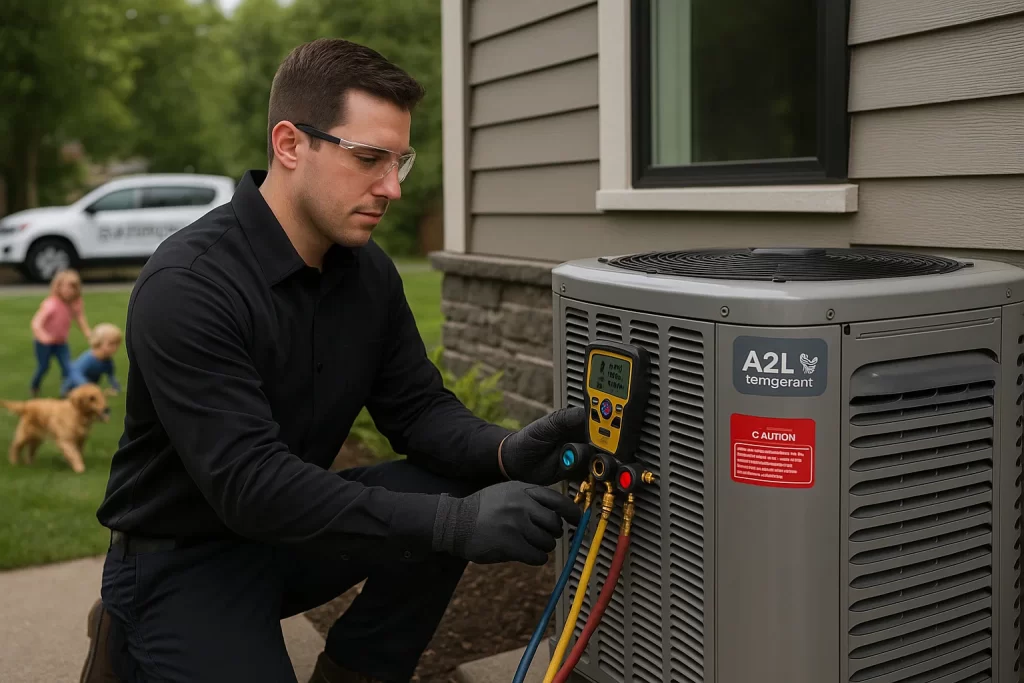The HVAC industry is entering a new era with the introduction of A2L refrigerants—a class of refrigerants that promise greater environmental responsibility without compromising performance. If you’ve heard about changes in refrigerant standards or are planning to install or replace an air conditioning system soon, understanding A2L refrigerants is essential. Here’s what they are, why they’re being adopted, and what benefits they offer.

What Are A2L Refrigerants?
A2L refrigerants are a new generation of mildly flammable, low-global warming potential (GWP) refrigerants. The term “A2L” is a classification used by ASHRAE (American Society of Heating, Refrigerating and Air-Conditioning Engineers) to describe refrigerants with low toxicity (A) and lower flammability (2L).
These refrigerants are designed to replace older, high-GWP refrigerants like R-410A, which have been widely used in residential and commercial air conditioning systems for years. While R-410A is non-flammable and highly effective at cooling, it has a very high GWP, meaning it contributes significantly to climate change when released into the atmosphere.
Why the Change from R-410A?
The move away from R-410A is part of a larger effort to reduce greenhouse gas emissions and combat global warming. The Environmental Protection Agency (EPA) and international agreements have driven legislation requiring the HVAC industry to adopt refrigerants with lower GWPs.
A2L refrigerants such as R-32 and R-454B offer similar cooling capabilities to R-410A but with significantly reduced environmental impact. For example, R-32 has a GWP of around 675, compared to R-410A’s GWP of 2,088. That’s nearly a 70% reduction in climate-damaging potential.
Benefits of A2L Refrigerants
1. Environmentally Friendly. The most obvious benefit of A2L refrigerants is their lower GWP, making them a more sustainable option for the future. By switching to A2Ls, manufacturers and homeowners can significantly reduce their carbon footprint.
2. Energy Efficiency. Many A2L refrigerants offer better heat transfer properties, which can lead to more efficient systems. This can translate into lower energy bills and improved system performance over time.
3. Future Compliance. As regulations tighten, using A2L refrigerants ensures your HVAC system is up to code and not reliant on a phased-out product. Installing systems that use A2L refrigerants now can help avoid costly retrofits or replacements down the road.
Safety and Installation Considerations
While A2L refrigerants are mildly flammable, they are still considered safe when handled properly. Their flammability is much lower than other classes like A3 (e.g., propane), and manufacturers have developed systems with built-in safeguards to minimize any risk.
However, these changes mean HVAC technicians must be trained and certified to work with A2L refrigerants. Proper ventilation, leak detection, and updated safety standards are part of the new installation and maintenance protocols.
The shift to A2L refrigerants is a crucial step toward a greener HVAC industry. These new refrigerants strike a balance between performance, safety, and environmental responsibility. If you’re considering a new HVAC system or retrofit, ask our technicians about A2L-compatible options. Embracing these changes today ensures better comfort, compliance, and sustainability for the years ahead.
Our team of Home Performance Experts has served the I-5 corridor from Blaine to Marysville, Oak Harbor to Concrete, and the San Juan Islands since 1972 with a mission of Improving Lives™. We look forward to serving you too! Contact Barron Heating and Cooling today for heat pump and air conditioning services.
